Microsoft 70-411 Exam Practice Questions (P. 4)
- Full Access (300 questions)
- Six months of Premium Access
- Access to one million comments
- Seamless ChatGPT Integration
- Ability to download PDF files
- Anki Flashcard files for revision
- No Captcha & No AdSense
- Advanced Exam Configuration
Question #16
HOTSPOT -
Your network contains an Active Directory domain named contoso.com.
You have several Windows PowerShell scripts that execute when client computers start.
When a client computer starts, you discover that it takes a long time before users are prompted to log on.
You need to reduce the amount of time it takes for the client computers to start. The solution must not prevent scripts from completing successfully.
Which setting should you configure? To answer, select the appropriate setting in the answer area.
Hot Area:
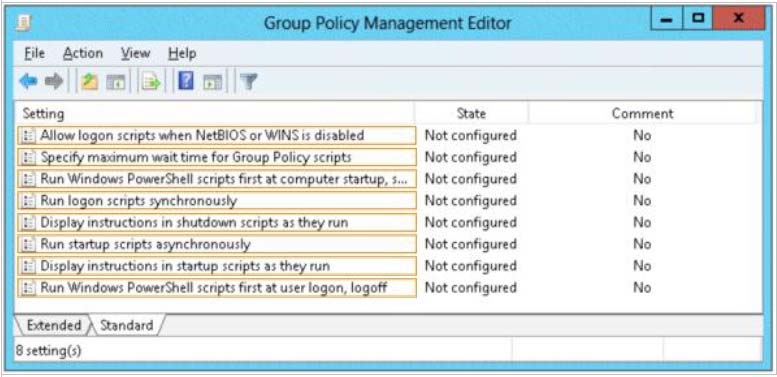
Your network contains an Active Directory domain named contoso.com.
You have several Windows PowerShell scripts that execute when client computers start.
When a client computer starts, you discover that it takes a long time before users are prompted to log on.
You need to reduce the amount of time it takes for the client computers to start. The solution must not prevent scripts from completing successfully.
Which setting should you configure? To answer, select the appropriate setting in the answer area.
Hot Area:

Correct Answer:
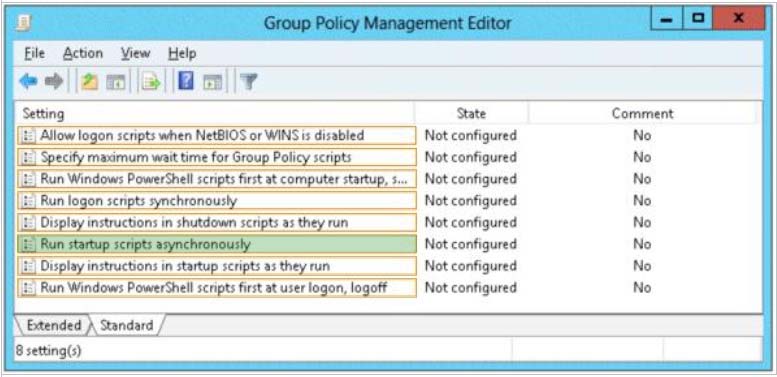
Lets the system run startup scripts simultaneously rather than waiting for each to finish http://technet.microsoft.com/en-us/library/cc939423.aspx
Directs the system to wait for logon scripts to finish running before it starts the Windows Explorer interface program and creates the desktop.
If you enable this policy, Windows Explorer does not start until the logon scripts have finished running. This setting assures that logon script processing is complete before the user starts working, but it can delay the appearance of the desktop.
If you disable this policy or do not configure it, the logon scripts and Windows Explorer are not synchronized and can run simultaneously.
This policy appears in the Computer Configuration and User Configuration folders. The policy set in Computer Configuration takes precedence over the policy set in User Configuration.
By default, the Fast Logon Optimization feature is set for both domain and workgroup members. This setting causes policy to be applied asynchronously when the computer starts and the user logs on. The result is similar to a background refresh. The advantage is that it can reduce the amount of time it takes for the logon dialog box to appear and the amount of time it takes for the desktop to become available to the user. Of course, it also means that the user may log on and start working before the absolute latest policy settings have been applied to the system.
Depending on your environment, you may want to disable Fast Logon Optimization. You can do this with Group Policy, using the Always wait for the network at computer startup and logon policy setting.
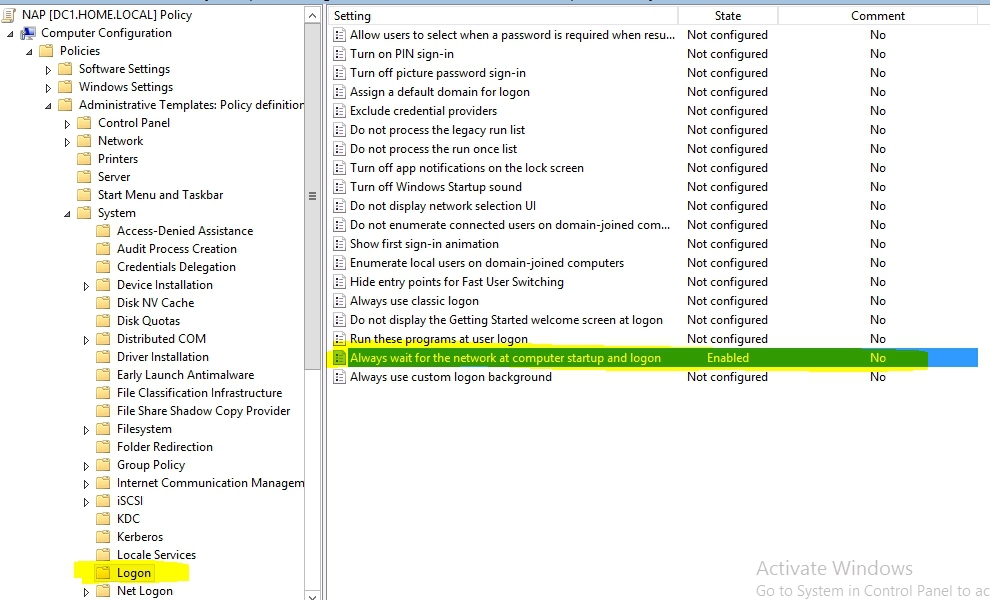
Refernces:
http://technet.microsoft.com/en-us/magazine/gg486839.aspx
http://technet.microsoft.com/en-us/library/cc958585.aspx

Lets the system run startup scripts simultaneously rather than waiting for each to finish http://technet.microsoft.com/en-us/library/cc939423.aspx
Directs the system to wait for logon scripts to finish running before it starts the Windows Explorer interface program and creates the desktop.
If you enable this policy, Windows Explorer does not start until the logon scripts have finished running. This setting assures that logon script processing is complete before the user starts working, but it can delay the appearance of the desktop.
If you disable this policy or do not configure it, the logon scripts and Windows Explorer are not synchronized and can run simultaneously.
This policy appears in the Computer Configuration and User Configuration folders. The policy set in Computer Configuration takes precedence over the policy set in User Configuration.
By default, the Fast Logon Optimization feature is set for both domain and workgroup members. This setting causes policy to be applied asynchronously when the computer starts and the user logs on. The result is similar to a background refresh. The advantage is that it can reduce the amount of time it takes for the logon dialog box to appear and the amount of time it takes for the desktop to become available to the user. Of course, it also means that the user may log on and start working before the absolute latest policy settings have been applied to the system.
Depending on your environment, you may want to disable Fast Logon Optimization. You can do this with Group Policy, using the Always wait for the network at computer startup and logon policy setting.

Refernces:
http://technet.microsoft.com/en-us/magazine/gg486839.aspx
http://technet.microsoft.com/en-us/library/cc958585.aspx
send
light_mode
delete
Question #17
HOTSPOT -
Your network contains an Active Directory domain named contoso.com. The domain contains a member server named Server1. Server1 runs Windows Server
2012 R2.
You enable the EventLog-Application event trace session.
You need to set the maximum size of the log file used by the trace session to 10 MB.
From which tab should you perform the configuration? To answer, select the appropriate tab in the answer area.
Hot Area:

Your network contains an Active Directory domain named contoso.com. The domain contains a member server named Server1. Server1 runs Windows Server
2012 R2.
You enable the EventLog-Application event trace session.
You need to set the maximum size of the log file used by the trace session to 10 MB.
From which tab should you perform the configuration? To answer, select the appropriate tab in the answer area.
Hot Area:

Correct Answer:
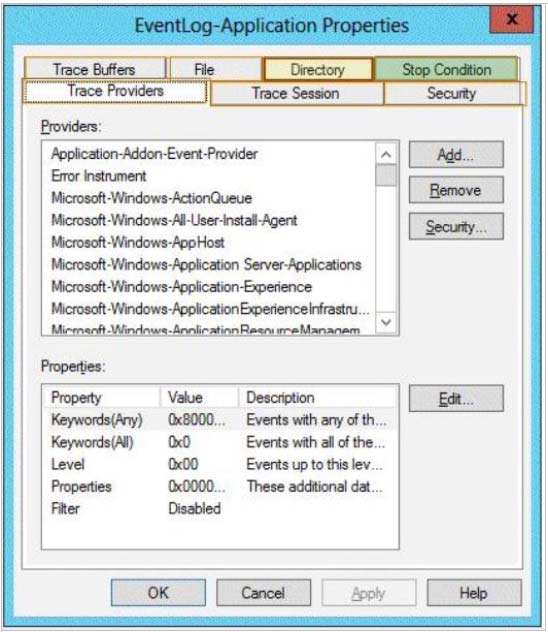
Note: By default, logging stops only if you set an expiration date as part of the logging schedule. Using the options on the Stop Condition tab, you can configure the log file to stop automatically after a specified period of time, such as seven days, or when the log file is full (if youve set a maximum size limit).
Reference: http://technet.microsoft.com/en-us/magazine/ff458614.aspx
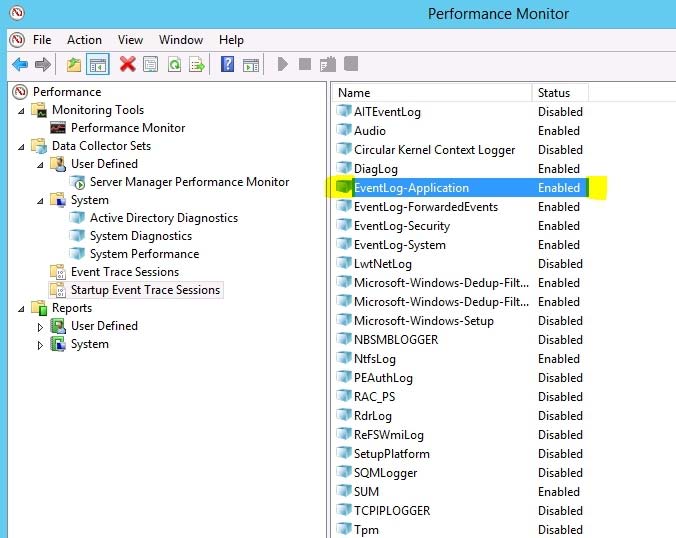
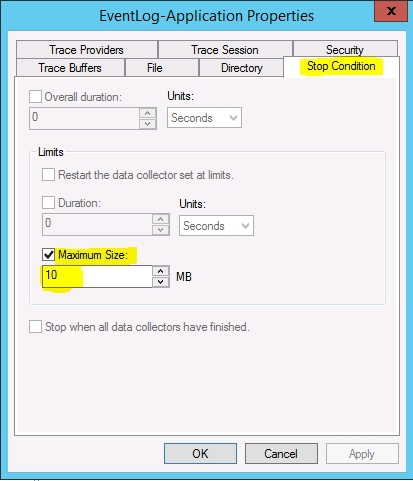

Note: By default, logging stops only if you set an expiration date as part of the logging schedule. Using the options on the Stop Condition tab, you can configure the log file to stop automatically after a specified period of time, such as seven days, or when the log file is full (if youve set a maximum size limit).
Reference: http://technet.microsoft.com/en-us/magazine/ff458614.aspx


send
light_mode
delete
Question #18
HOTSPOT -
Your network contains an Active Directory domain named contoso.com. The domain contains three member servers named Server1, Server2, and Server3. All servers run Windows Server 2012 R2 and have the Windows Server Update Services (WSUS) server role installed.
Server1 and Server2 are configured as replica servers that use Server3 as an upstream server.
You remove Servers from the network.
You need to ensure that WSUS on Server2 retrieves updates from Server1. The solution must ensure that Server1 and Server2 have the latest updates from
Microsoft.
Which command should you run on each server? To answer, select the appropriate command to run on each server in the answer area.
Hot Area:
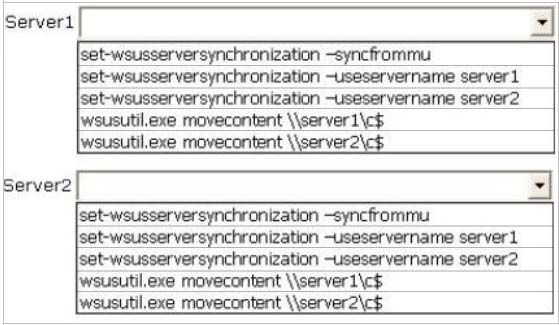
Your network contains an Active Directory domain named contoso.com. The domain contains three member servers named Server1, Server2, and Server3. All servers run Windows Server 2012 R2 and have the Windows Server Update Services (WSUS) server role installed.
Server1 and Server2 are configured as replica servers that use Server3 as an upstream server.
You remove Servers from the network.
You need to ensure that WSUS on Server2 retrieves updates from Server1. The solution must ensure that Server1 and Server2 have the latest updates from
Microsoft.
Which command should you run on each server? To answer, select the appropriate command to run on each server in the answer area.
Hot Area:

Correct Answer:
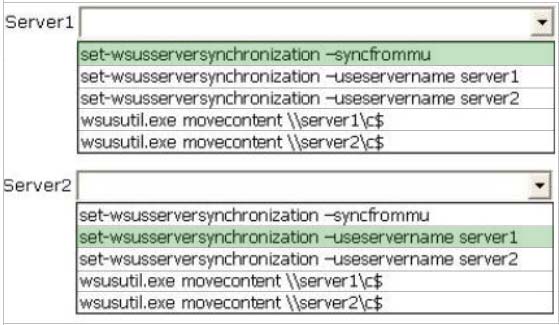
Set-WsusServerSynchronization-SyncFromMU [-UpdateServer<IUpdateServer> ] [-Confirm] [-WhatIf] [ <CommonParameters>]
Set-WsusServerSynchronization-UssServerName<String> [-PortNumber<Int32> ] [-Replica] [-UpdateServer<IUpdateServer> ] [-UseSsl] [-Confirm] [-WhatIf]
[ <CommonParameters>]
The Set-WsusServerSynchronizationcmdlet sets whether the Windows Server Update Services (WSUS) server synchronizes from Microsoft Update or an upstream server. This cmdlet allows the user to specify settings such as the upstream server name, the port number, and whether or not to use Secure Sockets
Layer (SSL).
References:
http://technet.microsoft.com/en-us/library/hh826163.aspx
http://technet.microsoft.com/en-us/library/cc708480%28v=ws.10%29.aspx

Set-WsusServerSynchronization-SyncFromMU [-UpdateServer<IUpdateServer> ] [-Confirm] [-WhatIf] [ <CommonParameters>]
Set-WsusServerSynchronization-UssServerName<String> [-PortNumber<Int32> ] [-Replica] [-UpdateServer<IUpdateServer> ] [-UseSsl] [-Confirm] [-WhatIf]
[ <CommonParameters>]
The Set-WsusServerSynchronizationcmdlet sets whether the Windows Server Update Services (WSUS) server synchronizes from Microsoft Update or an upstream server. This cmdlet allows the user to specify settings such as the upstream server name, the port number, and whether or not to use Secure Sockets
Layer (SSL).
References:
http://technet.microsoft.com/en-us/library/hh826163.aspx
http://technet.microsoft.com/en-us/library/cc708480%28v=ws.10%29.aspx
send
light_mode
delete
Question #19
You manage a server that runs Windows Server 2012 R2. The server has the Windows Deployment Services server role installed.
You have a desktop computer that has the following configuration:
✑ Computer name: Computer1
✑ Operating system: Windows 8
✑ MAC address: 20-CF-30-65-D0-87
✑ GUID: 979708BF-C04B-4525-9FE0-C4150BB6C618
You need to configure a pre-staged device for Computer1 in the Windows Deployment Services console.
Which two values should you assign to the device ID? (Each correct answer presents a complete solution. Choose two.)
You have a desktop computer that has the following configuration:
✑ Computer name: Computer1
✑ Operating system: Windows 8
✑ MAC address: 20-CF-30-65-D0-87
✑ GUID: 979708BF-C04B-4525-9FE0-C4150BB6C618
You need to configure a pre-staged device for Computer1 in the Windows Deployment Services console.
Which two values should you assign to the device ID? (Each correct answer presents a complete solution. Choose two.)
- C979708BF-C04B-452S-9FE0-C4150BB6C618
- D0000000000000000000020CF306SD087
- E00000000-0000-0000-0000-C41S0BB6C618
Correct Answer:
CD
In the text box, type the client computer's MAC address preceded with twenty zeros or the globally unique identifier (GUID) in the format: {XXXXXXXX-XXXX-
XXXX-XXX- XXXXXXXXXXXX}.
* To add or remove pre-staged client to/from AD DS, specify the name of the computer or the device ID, which is a GUID, media access control (MAC) address, or
Dynamic Host Configuration Protocol (DHCP) identifier associated with the computer.
* Example: Remove a device by using its ID from a specified domain This command removes the pre-staged device that has the specified ID. The cmdlet searches the domain named TSQA.contoso.com for the device.
Windows PowerShell -
PS C:\> Remove-WdsClient -DeviceID "5a7a1def-2e1f-4a7b-a792-ae5275b6ef92" -Domain -DomainName "TSQA.contoso.com"
CD
In the text box, type the client computer's MAC address preceded with twenty zeros or the globally unique identifier (GUID) in the format: {XXXXXXXX-XXXX-
XXXX-XXX- XXXXXXXXXXXX}.
* To add or remove pre-staged client to/from AD DS, specify the name of the computer or the device ID, which is a GUID, media access control (MAC) address, or
Dynamic Host Configuration Protocol (DHCP) identifier associated with the computer.
* Example: Remove a device by using its ID from a specified domain This command removes the pre-staged device that has the specified ID. The cmdlet searches the domain named TSQA.contoso.com for the device.
Windows PowerShell -
PS C:\> Remove-WdsClient -DeviceID "5a7a1def-2e1f-4a7b-a792-ae5275b6ef92" -Domain -DomainName "TSQA.contoso.com"
send
light_mode
delete
Question #20
You have Windows Server 2012 R2 installation media that contains a file named Install.wim. You need to identify the permissions of the mounted images in
Install.wim.
What should you do?
Install.wim.
What should you do?
- ARun dism.exe and specify the /get-mountedwiminfo parameter.
- BRun imagex.exe and specify the /verify parameter.
- CRun imagex.exe and specify the /ref parameter.
- DRun dism.exe and specify the/get-imageinfo parameter.
Correct Answer:
A
/Get-MountedWimInfo Lists the images that are currently mounted and information about the mounted image such as read/write permissions, mount location, mounted file path, and mounted image index.
References:
http://technet.microsoft.com/en-us/library/cc749447(v=ws.10).aspx http://technet.microsoft.com/en-us/library/dd744382(v=ws.10).aspx http://technet.microsoft.com/en-us/library/hh825224.aspx
A
/Get-MountedWimInfo Lists the images that are currently mounted and information about the mounted image such as read/write permissions, mount location, mounted file path, and mounted image index.
References:
http://technet.microsoft.com/en-us/library/cc749447(v=ws.10).aspx http://technet.microsoft.com/en-us/library/dd744382(v=ws.10).aspx http://technet.microsoft.com/en-us/library/hh825224.aspx
send
light_mode
delete
All Pages
